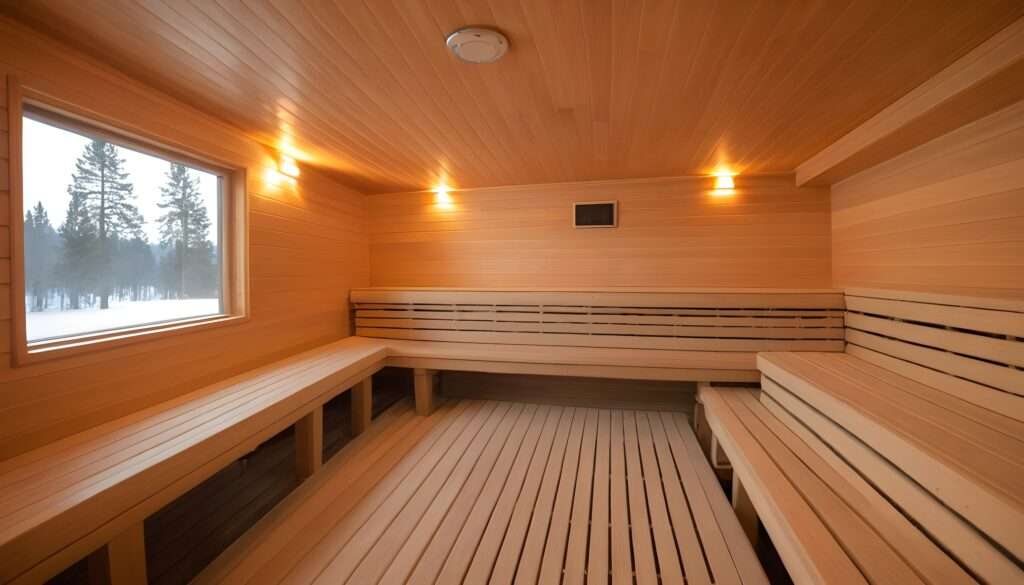Ever wondered if sitting in a sauna does more than just make you feel good? You know, that cosy warmth makes you sweat – but can it actually help burn calories and make you healthier?

Saunas might be more than just a warm escape; they could be your secret weapon against calories. Before we jump in, let’s take a quick tour around the world and see how saunas are a big deal in different places. From Finland to various corners of the globe, saunas have a cool history.
Whether you’re a sauna pro or just curious, we’re here to make it easy. From burning calories to other health perks, let’s explore saunas together and find out how they can make you feel good and maybe even healthier.
What is a Sauna?
A sauna, originating from Finnish and other Northern European cultures, is a heated space designed to promote relaxation and well-being through the experience of dry heat. Historically, saunas were integral to various cultures, with the Finnish sauna tradition being particularly renowned.
A sauna typically consists of an enclosed space, often made of wood, providing a comforting environment for users. The primary heat source can be electric heaters or wood-burning stoves, generating a dry heat that distinguishes saunas from other forms of steam baths. The temperature inside a sauna usually ranges from 150°F to 195°F, creating an environment that induces sweating and promotes a sense of tranquility.
Different Types of Saunas:
- Traditional Sauna: Featuring a wood-burning stove and stones, this classic sauna type embraces the authentic Finnish experience.
- Infrared Sauna: Utilizing infrared heaters, this type produces radiant heat that directly warms the body, often at lower temperatures than traditional saunas.
- Steam Room: While not a traditional sauna, steam rooms use moist heat to create a similar effect, promoting relaxation and potential health benefits.
Does Sauna Burn Calories?
Absolutely yes! Saunas can definitely help burn calories, although it’s essential to have realistic expectations about the extent of their impact.

The Science Behind It:
- When you step into a sauna, your body responds to the increased heat by working to regulate its core temperature. This natural process leads to a boost in metabolic rate, causing your body to burn more calories.
Estimated Calorie Range:
- During a sauna session, you can expect to burn anywhere from 100 to 600 calories. However, keep in mind that this figure varies based on factors like how long you stay in the sauna, your individual metabolism, body size, and even the environmental conditions.
While saunas contribute to calorie burning, it’s crucial not to view them as a miraculous weight loss solution on their own. Achieving and maintaining a healthy weight requires a balanced approach, including a nutritious diet and regular physical activity.
Comparison to Other Activities:
- To give you an idea, a 30-minute sauna session might burn approximately the same number of calories as a brisk walk or a light jog. So, while saunas offer a passive way to burn calories, they should be seen as just one part of an overall strategy for health and fitness.
To make the most of your sauna time, consider combining it with other healthy habits. Adding some light stretching or a bit of cardiovascular exercise after your sauna session can enhance calorie burning and contribute to your overall well-being.
Different Types of Sauna:
1. Finnish Sauna:

- Let’s start with the classic Finnish sauna, hailing from Finland. It’s the one you’ve probably seen in movies or heard about from friends.
- In this sauna, you’re in for a dry heat experience, with temperatures ranging from 150°F to 195°F (65°C to 90°C).
- The heat comes from electric heaters or wood-burning stoves, giving it that authentic feel.
- One of the highlights is the ritual of pouring water on heated rocks to create steam, known as löyly, adding a bit of humidity to the mix.
2. Infrared Sauna:

- If you’re looking for something a little different, consider trying an infrared sauna.
- Instead of heating the air around you, this sauna uses infrared radiation to directly warm your body. The air temperature stays lower, usually between 100°F to 130°F (38°C to 54°C).
- Fans of infrared saunas claim benefits like deeper heat penetration, muscle relaxation, and improved circulation, but experts are still exploring these claims to confirm their validity.
3. Steam Sauna:

- Ever heard of a Turkish bath? That’s what you get with a steam sauna.
- Prepare yourself for high temperatures, typically ranging from 100°F to 110°F (38°C to 43°C), and humidity levels that can reach 100%.
- It’s a steamy experience, literally, and offers a more intense sensation compared to dry saunas.
4. Smoke Sauna:

- Take a step back in time with the traditional Finnish smoke sauna.
- It’s a throwback to the old days when wood-burning stoves filled the sauna with aromatic wood smoke.
- While you might not find these saunas as commonly nowadays due to concerns about air quality, they offer a unique and nostalgic ambiance.
5. Salt Room:

- While not exactly a sauna, many sauna facilities include salt rooms as part of their offerings.
- These rooms maintain lower temperatures, usually around 70°F to 80°F (21°C to 27°C).
- The idea here is to inhale salt-infused air, which some people believe can benefit respiratory health and skin conditions.
- However, scientific research is still ongoing to validate these claims.
Benefits of Sauna:
While saunas are known for their calorie-burning perks, the health benefits extend far beyond, offering a holistic approach to well-being.

1. Relaxation and Stress Reduction:
- Saunas create a tranquil environment that promotes relaxation. The heat stimulates the release of endorphins, often referred to as the body’s natural feel-good chemicals.
- Simultaneously, stress hormones like cortisol decrease. Studies, such as those featured in the Journal of Physiological Anthropology, highlight the positive impact of saunas on stress reduction.
2. Improved Circulation:
- Entering a sauna induces a gentle cardiovascular workout. The heat raises your heart rate and encourages increased blood flow. This, in turn, can contribute to enhanced circulation.
- The dilation of blood vessels in response to the sauna environment is recognized for its potential cardiovascular benefits, as noted in the Journal of Applied Physiology.
3. Reduced Muscle Soreness:
- Saunas have shown promise in aiding muscle recovery and reducing post-exercise soreness, as suggested by studies like the one in the Journal of Science and Medicine in Sport.
- While additional research is needed for conclusive evidence, the sauna’s potential role in alleviating muscle discomfort adds another dimension to its benefits.
4. Skin Health:
- The combination of increased blood flow and sweating in saunas holds potential benefits for skin health.
- While not yet fully substantiated, a study in the International Journal of Cosmetic Science proposes that sauna sessions could positively impact skin texture and appearance.
- However, the need for further research emphasizes the ongoing exploration of these potential advantages.
Safety Consideration
While saunas offer a range of health benefits, it’s essential to prioritize safety to ensure a positive and risk-free experience. Here are two key considerations:
1. Hydration:
- Staying well-hydrated is non-negotiable when it comes to sauna use. The heat in saunas induces sweating, leading to fluid loss.
- It’s crucial to hydrate properly before, during, and after sauna sessions to prevent dehydration and maintain proper electrolyte balance.
- Dehydration can result in dizziness, weakness, and in extreme cases, more severe complications.
- Sipping on water throughout the sauna experience helps counteract fluid loss and ensures a safe and enjoyable session.
2. Duration and Frequency:
- While the allure of a sauna session might tempt you to linger, it’s important to exercise caution regarding the duration and frequency of use.
- Prolonged sessions can lead to overheating, potentially causing discomfort and other adverse effects.
- Beginners should start with shorter sessions, typically around 15-20 minutes, and gradually increase the duration based on individual tolerance.
- Similarly, the frequency of sauna use should be approached with moderation.
- Overdoing it may increase the risk of dehydration, fatigue, and other complications. Listening to your body and gradually acclimating to longer sessions can help mitigate potential risks and enhance the overall safety of sauna use.
Conclusion:
In wrapping up our exploration of saunas, here are the key takeaways:
- Limited Calorie Burn: Saunas do contribute to calorie burning, but they shouldn’t be viewed as a primary method for weight loss. The calorie burn is modest and should complement a broader approach to health.
- Beyond Weight Loss: Saunas offer potential health benefits, including stress reduction, improved circulation, and muscle recovery. However, some claims require further research for validation.
- Safety First: To enjoy saunas safely, prioritize hydration, start with shorter sessions, and gradually increase duration based on personal comfort. It’s advisable to consult a doctor, especially for individuals with existing health conditions.
While saunas can be a positive addition to your wellness routine, they work best when combined with a balanced diet and regular exercise. They are not a substitute but a complement to an overall healthy lifestyle.
FAQs:
1. How many calories burn in a 30-minute sauna session?
The calorie burn in a 30-minute sauna session can vary, typically ranging from 100 to 300 calories. Factors such as individual metabolism, body size, and sauna temperature contribute to the variability.
2. Is a sauna good for weight loss?
While saunas contribute to calorie burning and offer potential health benefits, they should not be considered a primary solution for weight loss. Saunas work best when combined with a balanced diet and regular exercise as part of an overall healthy lifestyle.
3. Does the sauna burn calories after a workout?
Yes, saunas can contribute to continued calorie burning after a workout. The elevated metabolic rate induced by the sauna’s heat may persist post-session. However, it’s essential to recognize that saunas are not a substitute for regular exercise and proper nutrition in achieving weight loss goals.
4. How long should I sit in a sauna?
The ideal duration for sauna sessions varies based on individual tolerance and experience. Beginners are recommended to start with shorter sessions, typically around 15 to 20 minutes, and gradually increase duration as they become accustomed to the heat.
By: Well and Fit Life

Pingback: What Is Zone 2 Cardio? The Ultimate Training You're Probably Missing |